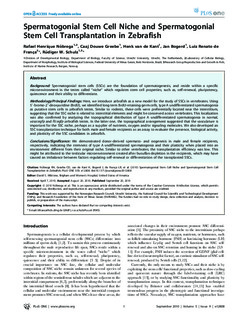| dc.description.abstract | Background
Spermatogonial stem cells (SSCs) are the foundation of spermatogenesis, and reside within a specific microenvironment in the testes called “niche” which regulates stem cell properties, such as, self-renewal, pluripotency, quiescence and their ability to differentiate.
Methodology/Principal Findings
Here, we introduce zebrafish as a new model for the study of SSCs in vertebrates. Using 5′-bromo-2′-deoxyuridine (BrdU), we identified long term BrdU-retaining germ cells, type A undifferentiated spermatogonia as putative stem cells in zebrafish testes. Similar to rodents, these cells were preferentially located near the interstitium, suggesting that the SSC niche is related to interstitial elements and might be conserved across vertebrates. This localization was also confirmed by analyzing the topographical distribution of type A undifferentiated spermatogonia in normal, vasa::egfp and fli::egfp zebrafish testes. In the latter one, the topographical arrangement suggested that the vasculature is important for the SSC niche, perhaps as a supplier of nutrients, oxygen and/or signaling molecules. We also developed an SSC transplantation technique for both male and female recipients as an assay to evaluate the presence, biological activity, and plasticity of the SSC candidates in zebrafish.
Conclusions/Significance
We demonstrated donor-derived spermato- and oogenesis in male and female recipients, respectively, indicating the stemness of type A undifferentiated spermatogonia and their plasticity when placed into an environment different from their original niche. Similar to other vertebrates, the transplantation efficiency was low. This might be attributed to the testicular microenvironment created after busulfan depletion in the recipients, which may have caused an imbalance between factors regulating self-renewal or differentiation of the transplanted SSCs. | no_NO |
